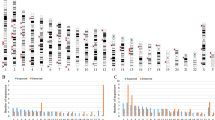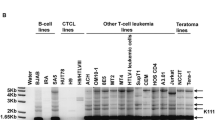Abstract
The human complement C4 genes in the HLA exhibit an unusual, dichotomous size polymorphism and a four-gene, modular variation involving novel gene RP, complement C4, steroid 21-hydroxylase (CYP21), and tenascin-like Gene X (RCCX). The C4 gene size dichotomy is mediated by an endogenous retrovirus, HERV-K(C4). Nearly identical sequences for this retrotransposon are present precisely at the same location in the long C4 genes from the tandem RCCX Module I and Module II. Specific nucleotide substitutions between the long and short C4 genes have been identified and used for diagnosis. Southern blot analyses revealed that HERV-K(C4) is present at more than 30 locations in the human genome, exhibits variations in the population, and its analogs exist in the genomes of Old World primates with species-specific patterns. Evidence of intrachromosomal recombination between the two long terminal repeats of HERV-K(C4) is found near the huntingtin locus on chromosome 4. It is possible that members of HERV-K(C4) are involved in genetic instabilities including the RCCX modules, and in protecting the host genome from retroviral attack through an antisense strategy.
Similar content being viewed by others
References
Anderson, G., Larhammar, D., Widmark, E., Servenius, B., Peterson, P. A., and Rask, L. Class II genes of the human major histocompatibility complex. J Biol Chem 262: 8748–8758, 1987
Ausubel, F. M., Brent, R., Kingston, R. E., Moore, D. D., Seidman, J. G., Smith, J. A., and Struhl, K. Current Protocols in Molecular Biology, Greene Publishing Associates and Wiley-Interscience, New York, 1987
Bankier, A. T. and Barrell, B. G. Sequencing single-stranded DNA using the chain-termination method. In C. J. Howe and E. S. Ward (eds.): Nucleic Acids Sequencing: A Practical Approach, pp. 37–78. IRL Press, Oxford, 1989
Baxendale, S., MacDonald, M. E., Mott, R., Francis, F., Lin, C., Kirby, S. F., James, M., Zehetner, G., Hummerich, H., Valdes, J., Collins, F. S., Deaven, L. J., Gusella, J. F., Lehrach, H., and Bates, G. P. A cosmid contig and high resolution restriction map of the 2 megabase region containing the Huntington's disease gene. Nature Genetics 4: 181–186, 1993
Belt, K. T., Yu, C. Y., Carroll, M. C., and Porter, R. R. Polymorphism of human complement component C4. Immunogenetics 21: 173–180, 1985
Bontrop, R. E., Broos, L. A. M., Otting, N., and Jonker, M. J. Polymorphism of C4 and CYP21 genes in various primate species. Tissue Antigens 37: 145–151, 1991
Bowes, C., Li, T., Frankel, W. N., Danciger, M., Coffins, J. M., Applebury, M. L., and Farber, D. B. Localization of a retroviral element within the rd gene coding for the beta subunit of cGMP phosphodiesterase. Proc Natl Acad Sci USA 90: 2955–2959, 1993
Bristow, J., Tee, M., Gitelman, S., and Miller, W. Tenascin-X: a novel cellular matrix protein encoded by the human XB gene overlapping P450c21B. J Cell Biol 122: 265–278, 1993
Cameron, J. R., Loh, E. Y., and Davis, R. W. Evidence for transposition of dispersed repetitive DNA families in yeast. Cell 16: 739–751, 1979
Carroll, M. C., Belt, T., Palsdottir, A., and Porter, R. R. Structure and organization of the C4 genes. Philos Trans R Soc Lond [Biol] 306: 379–388, 1984a
Carroll, M. C., Campbell, R. D., Bentley, D. R., and Porter, R. R. A molecular map of the human major histocompatibility complex class III region linking complement genes C4, C2 and factor B. Nature 307: 237–241, 1984b
Carroll, M. C., Palsdottir, A., Belt, K. T., and Porter, R. R. Deletion of complement C4 and steroid 21-hydroxylase genes in the HLA class III region. EMBO J 4: 2547–2552, 1985
Chiu, I.-M., and Skuntz, S. F. Nucleotide sequence analysis of squirrel monkey retrovirus reveals a novel primer-binding site for tRNA Lys. J Virol 58: 983–987, 1986
Cohen, M. and Larsson, E. Human endogenous retroviruses. Bioessays 9: 191–196, 1990
Genetics Computer Group, Inc. GCG Sequence Analysis Software Package: Program Manual, Version 7, Genetics Computer Group, Inc., Madison, 1991
Gorman, C.,High efficiency gene transfer into mammalian cells. In D. M. Glover (ed.): DNA Cloning: A Practical Approach, pp. 143–190, IRL Press, Oxford, 1985
Gray, D. A. Insertional mutagenesis: neoplasia arising from retroviral integration. Cancer Invest 9: 295–304, 1991
Horowitz, M., Luria, S., Rechavi, G., and Givol, D. Mechanism of activation of the mouse c-mos oncogene by the LTR of an intracisternal A-particle gene. EMBO J 3: 2937–2941, 1984
Jurka, J. and Smith, T. A fundamental division in the Alu family of repeated sequences. Proc Natl Acad Sci USA 85: 4775–4778, 1988
Kambhu, S., Falldorf, P., and Lee, J.. Endogenous retroviral long terminal repeats within the HLA-DQ locus. Proc Natl Acad Sci USA 87 4927–4931, 1990
Kawaguchi, H., O'hUigin, C., and Klein, J. Evolution of primate C4 and CYP21 genes. In J. Klein and D. Klein (eds.): Molecular Evolution of the Major Histocompatibility Complex, pp 357–381, Springer, Heidelberg Berlin New York, 1991
Kawaguchi, H., Zaleska-Rutczynska, Z., Figueroa, F., O'hUigin, C., and Klein, J. C4 genes of the chimpanzee, gorilla, and orang-utan: evidence for extensive homogenization. Immunogenetics 35: 16–23, 1992
Kuff, E. L. Intracisternal A particles in mouse neoplasia. Cancer Cells 2: 398–400, 1990
Larhammar, D., Servenius, B., Rask, L., and Peterson, P. A. Characterization of an HLA DRβ pseudogene. Proc Natl Acad Sci USA 82: 1475–1479, 1985
Li, W.-H. and Graur, D. Evolution by transposition. In W.-H. Li and D. Graur (eds.): Fundamentals of Molecular Evolution, pp. 172–203, Sinauer Associates, Sunderland, 1991
Lieb-Mosch, C., Halmeier, M., Werner, T., Geigl, E.-M., Brack-Werner, R., Francke, U., Erfle, V., and Hehlmann, R. Genomic distribution and transcription of solitary HERV-K LTRs. Genomics 18: 261–269, 1993
Maeda, N. Nucleotide sequence of the haptoglobin and haptoglobin-related gene pair. J Biol Chem 260: 6698–6709, 1985
Mager, D. L. and Henthorn, P. S. Identification of a retrovirus-like repetitive element in human DNA. Proc Natl Acad Sci USA 81: 7510–7514, 1984
Maurer, B., Banner, H., Darai, G., and Flugel, R. Analysis of the primary structure of the long terminal repeat and the gag and pol genes of the human spumaretrovirus. J Virol 62: 1590–1597, 1988
McCombie, W. R., Martin-Gallardo, A., Gocayne, J. D., FitzGerald, M., Dubnick, M., Kelley, J. M., Castilla, L., Liu, L. I., Wallace, S., Trapp, S., Tagle, D., Whaley, W. L., Cheng, L., Gusella, J., Frischauf, A.-M., Poustka, A., Lehrach, H., Collins, F. S., Kerlavage, A. R., Fields, C., and Venter, J. C. Expressed genes, Alu repeats and polymorphisms in cosmids sequenced from chromosome 4p16.3. Nature Genetics 1: 348–353, 1992
Messing, J. and Bankier, A. The use of single-stranded DNA phage in DNA sequencing. In C. J. Howe and E. S. Ward (eds.): NutNucleic Acids Sequencing: A Practical Approach, pp. 1–36, IRL Press, Oxford, 1989
Mountz, J. D. and Talal, N. Retroviruses, apoptosis and autogenes. Immunol Today 14: 532–536, 1993
Nottenburg, C., Stubblefield, E., nd Varmus, H. An aberrant Avian Leukosis Virus provirus inserted downstream from chicken c-myc coding sequence in a bursal lymphoma results from intrachromosomal recombination between two proviruses and deletion of cf celluar DNA. J Virol 61: 1828–1833, 1987
Ono, M., Yasunaga, T., Miyata, T., and Ushikubo, H. Nucleotide sequence of human endogenous retrovirus genome related to the mouse mammary tumor virus genome. J Virol 60: 589–598, 1986
Plasterk, R. Molecular mechanisms of transposition and its control. Cell 74: 781–786, 1993
Rosa, P. A., Sepich, D. S., Shreffler, D. C., and Ogata, R. T. Mice constitutive for sex limited (Slp) expression contain multiple Slp gene sequences. J Immunol 135: 627–631, 1985
Saiki, R. Amplification of genomic DNA. In M. A. Innis, D. Gelf, J. Sninsky, and T. White (eds.): PCR Protocols: A Guide to Methods and Applications, pp. 13–20, Academic Press, San Diego, 1990
Saltarelli, M., Querat, G., Konings, D. A. M., Vigne, R., and Clements, J. E. Nucleotide sequence and transcriptional analysis of molecular clones of CAEV which generate infectious virus. Virology 179: 347–364, 1990
Samuelson, L. C., Wiebauer, K., Snow, C. M., and Meisler, M. H. Retroviral and pseudogene insertion sites reveal the lineage of human salivary and pancreatic amylase genes from a single gene during primate evolution. Mol Cell Biol 10: 2513–2520, 1990
Sanger, F., Miklen, S., and Coulson, A. R. DNA sequencing with chain-termination inhibitors. Proc Natl Acad Sci USA 74: 5463–5467, 1977
Schneider, P. M. C4 DNA RFLP reference typing report. Complement Inflamm 7: 218–224, 1990
Shen, L. M., Wu, L. C., Sanlioglu, S., Chen, R., Mendoza, A. R., Dangel, A., Carroll, M. C., Zipf, W., and Yu, C. Y. Structure and genetics of the partially duplicated gene RP located immediately upstream of the complement C4A and C4B genes in the HLA class III region. J Biol Chem 269: 8466–8476, 1994
Southern, E. M. Detection of specific sequences among DNA fragments separated by gel electrophoresis. J Mol Biol 98: 503–517, 1975
Staden, R. An interactive graphics program for comparing and aligning nucleic acid and amino acid sequences. Nucleic Acids Res 12: 505–519, 1982
Stavenhagen, J. B. and Robins, D. M. An acient provirus has imposed androgen regulation on the adjacent mouse sex-limited protein gene. Cell 55: 247–254, 1988
Steele, P. E., Rabson, A. B., Bryan, T., and Martin, M. A. Distinctive termini characterize two families of human endogenous retroviral sequences. Science 225: 943–947, 1984
The Huntington's Disease Collaborative Research Group: A novel gene containing a trinucleotide repeat that is expanded and unstable on Huntington's Disease chromosomes. Cell 72: 971–983, 1993
Travis, J. Possible evolutionary role explored for “jumping genes”. Science 257: 884–885, 1992
Varmus, H. and Brown, P. Retroviruses. In D. E. Bergand M. M. Howe (eds.): Mobile DNA, pp. 53–108, American Society for Microbiology, Washington, 1989
Wilkinson, D. A., Maeger, D. L., and Leong, J.-A. C. Endogenous human retroviruss. In J. A. Levy (ed.): The Retroviridae (Vol 3), pp. 465–535, Plenum Press, New York, 1994
Wu, J., Zhou, T., He, J., and Mountz, J. D. Autoimmune disease in mice due to integration of an endogenous retrovirus in an apoptosis gene. J Exp Med 178: 461–468, 1993
Xiong, Y. and Eickbush, T. H. Origin and evolution of retroelements based upon their reverse transcriptase sequences. EMBO J 9: 3353–3362, 1990
Yu, C. Y. The complete exon-intron structure of a human complement component C4A gene: DNA sequences, polymorphism, and linkage to the 21-hydroxylase genes. J Immunol 146: 1057–1066, 1991
Yu, C. Y., Belt, K. T., Giles, C. M., Campbell, R. D., and Porter, R. R. Structural basis of the polymorphism of human complement component C4A and C4B: gene size, reactivity and antigenicity. EMBO J 5: 2873–2881, 1986
Yu, C. Y. and Campbell, R. D. Definitive RFLPs to distinguish between the human complement C4A/C4B isotypes and the major Rodgers/Chido determinants: application to the study of C4 null alleles. Immunogenetics 25: 384–390, 1987
Author information
Authors and Affiliations
Rights and permissions
About this article
Cite this article
Dangel, A.W., Mendoza, A.R., Menachery, C.D. et al. The dichotomous size variation of human complement C4 genes is mediated by a novel family of endogenous retroviruses, which also establishes species-specific genomic patterns among Old World primates. Immunogenetics 40, 425–436 (1994). https://doi.org/10.1007/BF00177825
Received:
Revised:
Issue Date:
DOI: https://doi.org/10.1007/BF00177825




